Application Notes
Introduction to Thermal Aging in Molded Power Inductors
ANP128 by Ing. Carlos Farnos, Dr.-Ing. Efrain Bernal
01. INTRODUCTION
The constant market demand to increase power density and efficiency, as well as making the power supply electronics smaller, has pushed each element inside the system to its limits. Moreover, greater power requirements and miniaturization expose passive electronic components to higher and higher temperatures, increasing the probability of the thermal aging. This is a representative phenomenon that can be found in molded power inductors even with AEC-Q200 Grade 0 qualification (operating temperature range between - 55 °C to 150 °C). This note will discuss the issues that inductors face when exposed to high temperatures for extended periods of time, with a special focus on molded high current power inductors and the necessity to recognize the effects of thermal aging in the inductor selection.
02. MOLDED POWER INDUCTORS
Many SMD power inductors use a technology called molding to press a magnetic metal alloy powder around the coil rather than use a discrete core. These inductors have superior magnetic shielding with low magnetic flux leakage, reduced potential for acoustic noise (high-pitched sounds when they are running), and a soft saturation roll off characteristic. Molded inductors are often more robust and reliable than other forms of power inductors, such those assembled from two-piece cores or single piece cores (drum core) with epoxy resin coatings, making them well-suited for usage in harsh or demanding settings. The powdered materials used in molded power inductors have minimal change in inductance with temperature and do not easily reach magnetic saturation. This is reflected in higher saturation current Isat specifications, making the inductor suitable for applications that require well-controlled inductance values at high currents and temperatures. A new generation of power semiconductors based on SiC and GaN technologies have raised the requirements in terms of working frequency and power density. If traditional MOSFET technologies have been used in the range of 100 kHz to 500 kHz with some exceptions up to 1 MHz and power limited to 2 kW/m³, the new semiconductors are capable of operating at 10 times higher frequency (generally up to 10 MHz) at a power density up 10 kW/ m³ [1]. This places new demands on all the other power handling components, including inductors. 2.1 Characteristics of Molded Power Inductors As the operating current and temperature increases, power inductors using ferrite cores become more susceptible to magnetic saturation resulting in system failure due to a sudden decrease in inductance. For this reason, designers use molded power inductors based on powdered magnetic alloy materials, to achieving more stable performance at high temperatures under high current operation, as shown in the Figure 1. However, saturation current (Isat) is only one of the many important characteristics to consider for inductor selection [2]: Inductance (L), temperature rise based on rated current (Irp), DC resistance (Rdc), AC and DC power losses [3] are also important, depending on the eventual application. Molded power inductors must operate with minimum power losses to meet efficiency requirements of over 95 % with high-temperature stability (both in magnetic properties as well as in terms of long-term reliability). Power losses in a magnetic component are split up into two types: core power losses and winding power losses. Winding losses are related to direct current (DC) resistance due to bulk cross section of the conductor, and alternating current (AC) resistance in a conductor in the form of skin effect and proximity effect [4]. A high Rdc directly affects the I2R power loss and voltage drop due to the large DC current flow through the inductor coil. The low permeability of powdered magnetic alloy materials means the number of turns in the coil must be increased to obtain a desired inductance, increasing the length of wire which raises the Rdc. Core power losses, on the other hand, are related to the material used to make the core of inductors; in this case, parameters such as geometric shape, volume, operating temperature range, operating frequency range, and magnetic saturation point must be taken into account [5]. Core losses mainly consist of hysteresis losses and eddy current losses. Hysteresis losses are related to the movement of magnetic domains within the material as the flux density changes which consumes energy resulting in thermal heating (energy not doing useful work). On the other hand, eddy currents are induced within the core of the inductor because it is conductive. At the surface of the core eddy currents flow in phase with the coil current whereas induced currents inside the core are out of phase due to inductive reactance. These characteristics can be improved by the type of materials used for the construction of the power inductor [6]. Many different magnetic materials are currently available on the market for inductor manufacturing that include traditional soft magnetic ferrites (Mn-Zn, Ni-Zn and Ni-Cu-Zn), soft magnetic metals (Si-Fe, amorphous, nanocrystalline) or powdered metal alloys (Fe-Si, Fe-Ni, Fe-Co). Though the base materials of metal alloy powdered cores have high permeability, their structure of isolated grains introduces a distributed nonmagnetic gap in the magnetic path, lowering their effective permeability, μe to less that 200 (generally 14- 300). Ferrites and soft magnetic metals, both with high permeability (>1000) must be gapped when used for inductors. Inserting a gap into the magnetic path causes the hysteresis curve to tilt, reducing the effective permeability and therefore, requiring more magnetic force (current) to reach saturation. However, the gap's high magnetic resistance (reluctance) causes a field concentration in and around it which induces high eddy currents into nearby windings whereas distributed gaps do not. As an alternative to ceramic materials with low saturation flux density, powdered magnetic alloys offer 2 to 3 times higher saturation flux density, and are available in many different material combinations for optimization to specific applications.
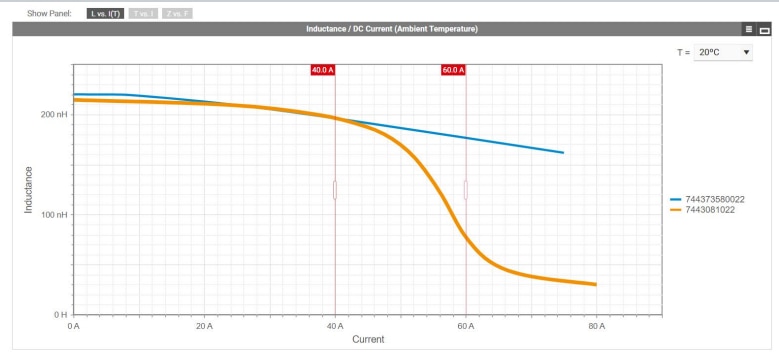
a. Saturation at an ambient temperature of 20ºC
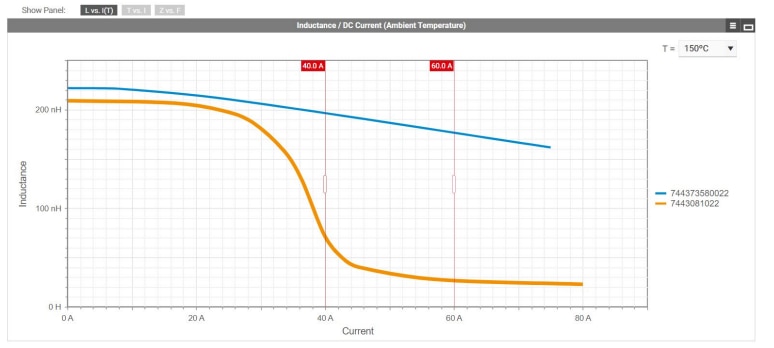
b. Decrease of Q value at 2 MHz during 1000 h at 200 0 C.
Figure 1: Saturation current (Isat) comparison between a hard saturation ferrite power inductor (orange color) and soft saturation powdered alloy power inductor (blue color) at different ambient temperatures displayed by REDEXPERT.
Powdered magnetic alloy particles are coated with a thin electric insulation layer and bonded together by a polymer or other material. The microstructure is illustrated in Figure 2. This type of magnetic core is called a soft magnetic composite (SMC).

Figure 2: Typical microstructures and schematic eddy current paths of (a) traditional metal/alloy soft magnetic materials and (b) SMCs.[2]
The coated particles together with a binder are compacted under high pressure to form the core geometry. This distributed insulation layer separates the particles into many short unconnected electric paths to effectively reduce the eddy current losses. Additionally, the insulation coating and binder provide an even distributed gap along the magnetic path. Hence, SMC cores are suitable for high current and high frequency operation. In an ideal scenario, there would be far less eddy current within a single particle than there would be if the particles were electrically conductive to one another within the core. This differs from ferrite cores which have a natural high material resistivity or from conductive soft magnetic metals which are made into insulated thin sheets or ribbons. For high frequency applications, this construction difference overcomes performance limitations of low permeability. Due to the distributed gap, SMC exhibits superior high DC bias handling, and exceptional temperature stability when compared to ferrite materials. These qualities make SMC is a great choice for applications requiring high current and highpower density. However, the expected long term temperature stability in molded power inductors is sometimes compromised when the component is exposed to high temperatures for long periods of time and used at high frequencies. Here we focus on the degradation mechanism of the magnetic material, specifically on the deterioration of the insulation coating of powder particles in the inductor core and their relationship with the decrease of the inductor performances.
03. THERMAL AGING IN MOLDED POWER INDUCTORS
3.1 Thermal Aging effect in Molded Material Mixtures
Thermal aging refers to long-term, irreversible changes in the structure, content, and morphology of soft magnetic composite cores. The degradation mechanism is triggered by the continued exposure at high temperatures over an extended period which modifies the electrical insulation between the core particles. This results in substantially increased core losses, decreasing the inductor’s performance and its functionality in a SMPS application. Some of the indicators of this undesirable phenomenon are higher power losses, increase of self-heating, increase of electromagnetic emissions (EMI), and decrease of the quality factor Q at high frequencies. Changes in the appearance of the core material are part of the observable phenomenon that can also be related to the performance decrease. The magnitude of these changes is directly related to the core temperature, the exposure time and core material itself. To get a better understanding of the first effect of thermal aging, a test has been performed by comparing different molded power inductors at 200 °C for a period of 1000 h. Figure 3 shows how higher temperatures have a general effect on the material's appearance.
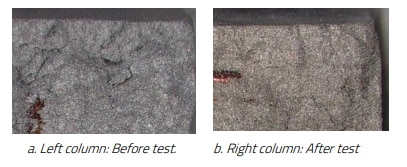
Figure 3: Molded Power Inductors of the same reference and Lot number, with AEC-Q200 grade 0 (- 55 °C to +150 °C) qualification, before test (left column) and after test (right column) at 200 0C during of 1000 h.
Over long periods of time, exposed at high temperatures, the insulation coating and binders of the iron powder begin to break down, reducing the resistivity of the material. Some manufacturers offer molded power inductors with AEC-Q200 qualification, however, there is a significant difference between a qualified inductor with and without a sturdy thermal aging improvement.
This is more evident when the tested components are analyzed in more detail, as shown in Figure 4. The discoloration effect exhibited in Figure 3 is related to the burning of the inter-particle insulation of the materials and the merging of coating material. The results show that at higher temperatures, some components appear to permeate into the powder particles from the boundary, reducing the insulating barrier on the particle surface [8], and the tiny air gaps of the SMC material. The results presented in Figure 3 and in Figure 4 reveal the impact of high temperatures on the core material even if the inductor is AEC-Q200 grade 0 (- 55_o C to +150 o C) qualified. As a designer, one must ask, why is this not detected during standardized testing during qualification? Main reason is that qualification tests are often based on the data sheet and the user’s general component specifications (i.e. environmental, etc.) which may not include power loss changes over time. Power inductors characteristics are often specified at 100 kHz, 100 mV/10 mA with and without DC bias. Normally this degradation phenomenon has little effect at this low frequency but it is very significant in the MHz range. For this reason, according to the AEC-Q200 acceptance criteria the thermal aging effect is mostly undetected.
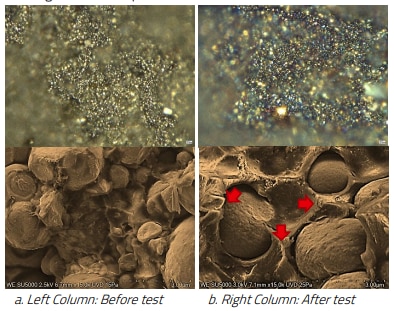
Figure 4: The first row shows some burned areas after the test obtained with a microscope reference zoom at 1000X. The second row refers to scanning electron microscope (SEM) images and evidences a significant binder thickness reduction and the degradation, represented by the formation of secondary layers with seared material.
3.2 Thermal Aging effect in performance of Inductors
When a molded power inductor is used for energy storage in a switching power supply, the effect of thermal aging is more prevalent at high voltages and frequencies.
The larger the AC component of the inductor current is, the larger will be the proportion of the AC losses over the total losses. The increase of the AC losses will generate extra heat to be dissipated into the ambient, which will translate into higher operating temperatures further potentially fueling this degradation process. This process carries the risk to turn into a catastrophic thermal runaway failure that compromises the complete system reliability. When an inductor is used for EMI filtering purposes, the degradation due to thermal aging, in addition to AC losses increasing in the core, reduces the AC impedance of the inter particle connection in the powder affecting the impedance curve and reducing its effectiveness. This degradation process can be monitored by measuring the Q value of the inductor over the time. The Q is defined as the inductive reactance divided by the resistance at a given frequency (both Rdc and Rac resistance are taken into consideration). Therefore, Q value is directly related to the power losses. A test has been performed by using our new molded power inductors, WE-LHMI 7443732448100 and WE-LHMI 7443734948100, with an inductance value of 10 µH, against some popular competitors with similar size and inductance value. All the inductors under test, 100 samples in total, were exposed to a constant temperature of 200 0 C in a climatic chamber and periodically measured to monitor any change to the L and Q value, during the 1000-hour test. The selected inductors correspond to molded power inductors with a AECQ grade 0 qualification, and those with a grade 1 qualification but with a reported maximal operation temperature higher than 150 0C. In the Figure 5-a, it is possible to trace that the reported inductance value of 10 µH stays between the ±20 % tolerance band, at the test conditions of 100 kHz (common for AECQ testing), during the 1000 hour test. This illustrates why it is not possible for designers to determine some changes in the performance by just measuring the inductance under typical test conditions reported in the datasheets. However, it can be seen that the quality factor Q decreases during prolonged exposure to higher temperatures as showed in Figure 5-b. The figure presents the case of the quality factor Q obtained at a frequency of 2 MHz. Results show that, even for an inductor with the better AEC-Q200 qualification, the decrease can be significant, even though the measured inductance values were within tolerances.
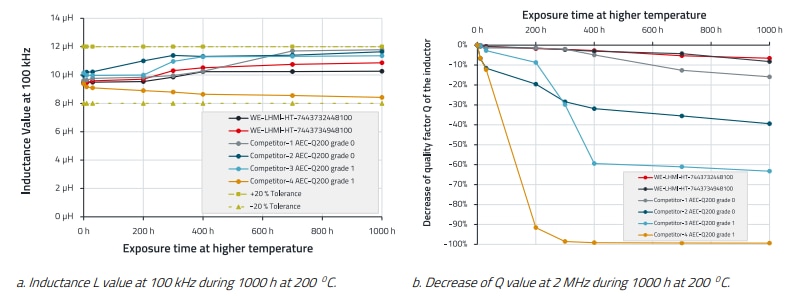
Figure 5: Performance comparison WE-LHMI HT version against competitors with AEC-Q200 qualification and reported temperature support more than 125°C
Whereas the Q value is continuously decreasing over the time for some competitor‘s inductors, the tested WE-LHMI power molded inductors remain almost constant. Hence, for high temperature applications, the tested competitor’s inductors experience a constant decrease in efficiency and consequently increasing operating temperature compromising the long-term reliability of the system. At a low frequency, there is no noticeable difference in Q value in concordance with the measured L value. However, the results of the test show a critical decrease of performance when the molded power inductor is used at frequencies higher than 100 kHz. Würth Elektronik eiSos measures AC-losses with a triangular ripple current, i.e. a rectangular wave voltage, similar to the real operating conditions of SMPS. The higher harmonic content of short duty cycle rectangular waveforms makes it necessary to use an advanced inductor measurement system for measuring power inductor‘s AC-losses. It is possible to observe an increase in AC losses from the high frequency harmonics of the waveform resulting in an increase in the component's self-heating. Würth Elektronik eiSos offers a full range of power molded inductors as part of the extensive portfolio of electronic components that are suitable for a wide range of temperature and applications. The new generation of molded power inductor series are available with different characteristics, as presented in Table 1. Designers have the possibility to select the right power molded inductor for their application within a huge range of sizes, performance, and structure. Targeting modern, demanding applications, the High Temperature WE-Molded Power Inductors Series offer a wide operating temperature from -55 °C to +150 °C with AEC-Q200 grade 0 qualification, with no thermal aging concerns.
04. SUMMARY
In this application note, Würth Elektronik eiSos responses to identified challenges in passive components, particularly the impact of thermal aging on molded power inductor performance, as expressed by our customers. Some important aspects have been addressed such as the impact of long exposure at high temperatures on material mixtures and its effects on the performance of molded power inductors. Moreover, we have presented a critical Q value decrease in competitors molded power inductors even with AEC-Q200 grade 0 qualification, which is associated with an increase in power losses and can barely be detected using standard measurement parameters. Furthermore, by recognizing the crucial role of temperature stability in power electronics, Würth Elektronik eiSos has developed a new series of high-temperature products that are free of thermal aging. This innovative solution ensures enhanced reliability and efficiency in demanding applications, aligning with the evolving needs of the industry for resilient and highperformance passive components.
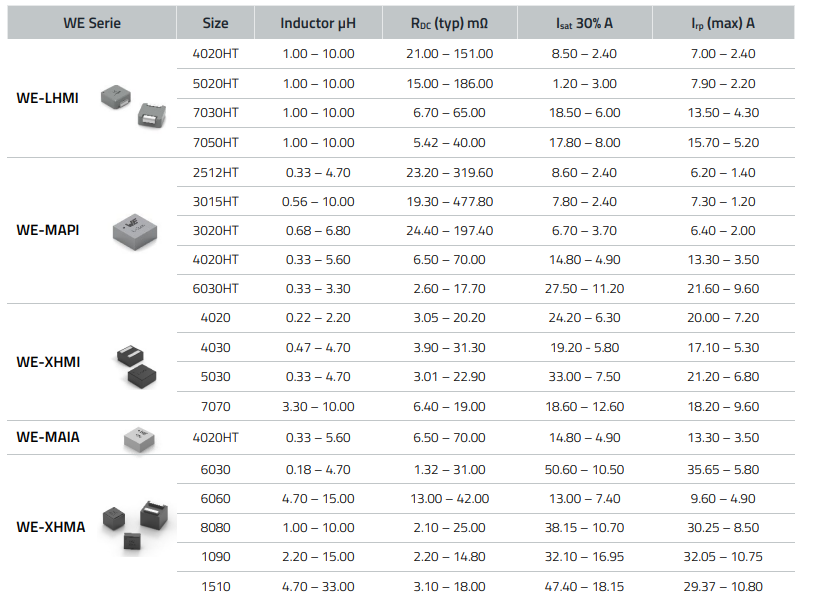
Table 1: High Temperature WE-Molded Power Inductors Series, with AEC-Q200 grade 0 qualification, designed to avoid Thermal Aging
A Appendix
A.1 References
[1] Kasper, Matthias J., et al. "Next Generation GaN-based Architectures: From 240W USB-C Adapters to 11kW EV On-Board Chargers with Ultra-high Power Density and Wide Output Voltage Range." PCIM Europe 2022; International Exhibition and Conference for Power Electronics, Intelligent Motion, Renewable Energy and Energy Management. VDE. (2022)
[2] APPLICATION NOTE Power Inductors 8 Design Tips: A practical guide for the selection of power inductors for DC/DC converters. (201x)
[3] Bramanpalli, Ranjith. APPLICATION NOTE "Accurate Inductor Loss Determination Using Würth Elektronik’s REDEXPERT." (2015)
[4] Rodriguez-Sotelo, D., et al. "Power Losses Models for Magnetic Cores: A Review. Micromachines 2022, 13, 418." (2022).
[5] Dobrzański, L. A., M. Drak, and Bogusław Ziębowicz. "Materials with specific magnetic properties." journal of achievements in materials and manufacturing engineering 17.1-2 (2006): 37-40.
[6] Jose Martos, Heinz Zenkner, APPLICATION NOTE ANP074 Introduction to RF Inductors. (2023)
[7] He, Jiayi, et al. "Soft magnetic materials for power inductors: State of art and future development." Materials Today Electronics. (2023)
[8] Nolan, William Rane. "Electrically insulating phosphate coatings for iron powder based electromagnetic core applications." PhD diss., Massachusetts Institute of Technology, 2009.
IMPORTANT NOTICE
The Application Note is based on our knowledge and experience of typical requirements concerning these areas. It serves as general guidance and should not be construed as a commitment for the suitability for customer applications by Würth Elektronik eiSos GmbH & Co. KG. The information in the Application Note is subject to change without notice. This document and parts thereof must not be reproduced or copied without written permission, and contents thereof must not be imparted to a third party nor be used for any unauthorized purpose. Würth Elektronik eiSos GmbH & Co. KG and its subsidiaries and affiliates (WE) are not liable for application assistance of any kind. Customers may use WE’s assistance and product recommendations for their applications and design. The responsibility for the applicability and use of WE Products in a particular customer design is always solely within the authority of the customer. Due to this fact it is up to the customer to evaluate and investigate, where appropriate, and decide whether the device with the specific product characteristics described in the product specification is valid and suitable for the respective customer application or not. The technical specifications are stated in the current data sheet of the products. Therefore the customers shall use the data sheets and are cautioned to verify that data sheets are current. The current data sheets can be downloaded at www.we-online.com. Customers shall strictly observe any product-specific notes, cautions and warnings. WE reserves the right to make corrections, modifications, enhancements, improvements, and other changes to its products and services. WE DOES NOT WARRANT OR REPRESENT THAT ANY LICENSE, EITHER EXPRESS OR IMPLIED, IS GRANTED UNDER ANY PATENT RIGHT, COPYRIGHT, MASK WORK RIGHT, OR OTHER INTELLECTUAL PROPERTY RIGHT RELATING TO ANY COMBINATION, MACHINE, OR PROCESS IN WHICH WE PRODUCTS OR SERVICES ARE USED. INFORMATION PUBLISHED BY WE REGARDING THIRD-PARTY PRODUCTS OR SERVICES DOES NOT CONSTITUTE A LICENSE FROM WE TO USE SUCH PRODUCTS OR SERVICES OR A WARRANTY OR ENDORSEMENT THEREOF. WE products are not authorized for use in safety-critical applications, or where a failure of the product is reasonably expected to cause severe personal injury or death. Moreover, WE products are neither designed nor intended for use in areas such as military, aerospace, aviation, nuclear control, submarine, transportation (automotive control, train control, ship control), transportation signal, disaster prevention, medical, public information network etc. Customers shall inform WE about the intent of such usage before design-in stage. In certain customer applications requiring a very high level of safety and in which the malfunction or failure of an electronic component could endanger human life or health, customers must ensure that they have all necessary expertise in the safety and regulatory ramifications of their applications. Customers acknowledge and agree that they are solely responsible for all legal, regulatory and safety-related requirements concerning their products and any use of WE products in such safety-critical applications, notwithstanding any applications-related information or support that may be provided by WE. CUSTOMERS SHALL INDEMNIFY WE AGAINST ANY DAMAGES ARISING OUT OF THE USE OF WE PRODUCTS IN SUCH SAFETYCRITICAL APPLICATIONS
DIRECT LINK
ANP128 | Introduction to Thermal Aging in Molded Power Inductors
USEFUL LINKS:
Application Notes : https://we-online.com/en/support/knowledge/application-notes
Services: https://we-online.com/en/products/components/service
Contact : https://we-online.com/en/support/contact
CONTACT INFORMATION
Würth Elektronik eiSos GmbH & Co. KG
Max-Eyth-Str. 1, 74638 Waldenburg, Germany
Tel.: +49 (0) 7942 / 945 – 0
Email: appnotes@we-online.de

